Curt
Member
- Joined
- Feb 1, 2014
- Messages
- 426
This is more like a museum report than a trip report. But it did involve a 4 mile hike. Agate Fossil Beds is in western Nebraska near the Wyoming border. It's pretty remote - about 100 miles from I-80 and I-25 and about 200 miles from I-90. The closest town is Harrison, Nebraska, population 250 which is about 30 miles away. The next closest is about 50 miles away. Agate Fossil Beds is probably not a place that most people will pop in to visit on their way somewhere else.
If you like history and geology / fossils this is good place to visit. There's a nice little museum at the Monument. Half of it is devoted to fossils found at the site, but the other half actually fascinated me more. In 1880 James Cook homesteaded a ranch in this location. Mr Cook was something of a renaissance man. Besides being a successful rancher he became interested in fossils from a chance encounter with a Yale University professor while guiding hunting trips in the Big Horn mountains in Wyoming. In the mid 1880's he found fossils on his ranch and invited his contact from Yale to make a visit to see the fossils. It turned out to be quite a find. Beginning in about 1900 and continuing for about 30 years excavations were conducted by several universities and museums at two hills on the ranch. The hills are named University Hill and Carnegie Hill (for the Carnegie Museum. The special significance of the hills were that the tops of the them are all that remains of an ancient waterhole. The reason for the massive die-off at the water hole is uncertain, but there is layer of mudstone on the hilltops containing hundreds, maybe thousands, of remains of animals from that ancient time, many of which were entire skeletons. Fossils found at the Agate Fossil beds include: (from Wikipedia)
The other half of the museum contains a collection of Plains Indian relics given to Mr. Cook by tribes living in the area. The 1880's basically marked the end of Horse Culture of the Plains Indians. Custer's Last Stand at Little Bighorn occurred in 1876. Before that time, but especially after Little Bighorn the U.S. army was engaged in continuous military operations against the Plains Indians to subdue them. The museum contains an impressive collection of items from the height of the Plains Indian Horse Culture. There are some items in the museum that I was astonished to see in such a remote museum. They probably belong in a more prominent museum like the Smithsonian. There are a few authentic items from the battle at Little Bighorn and at least a one other battle between a Sioux tribe and the U.S. Army. A personal item belonging to Crazy Horse which was removed at burial by his sister after he was killed while in U.S. Army custody at Ft. Robinson (a little farther north in Nebraska) is also in the museum. Last year I went to an event at a Nebraska State Park (a little farther south in Nebraska) that, among other things, had a gathering of Sioux from Pine Ridge Reservation along the South Dakota - Nebraska border. Some people from the tribe had been working with the Smithsonian Museum to help them identify and preserve items in the Smithsonian collection from the Plains Indians. As a thank you the Smithsonian Museum sent several items to the museum at the State Park for the event. As cool as that stuff was, it wasn't any better than the stuff in this museum. I think that the only explanation for items of such historical significance being in such a remote museum is that Cook's family must have insisted that these things remain at the Monument as a condition for giving them.
The fossils on the right are from a rhinoceros. The one on the left is a bear-dog.
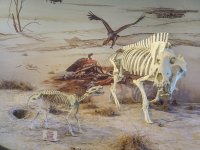
A camel.

I'm afraid I didn't get a picture of the high-tops
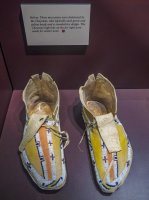
Some ceremonial moccasins also had beads on the bottom.
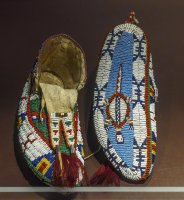


A Sioux wedding dress.
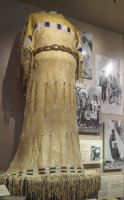
The "Battle of Greasy Grass" is the Sioux name for Custer's Last Stand.

This copy of the original cowhide describing the Battle of Little Bighorn described above is displayed in the Museum. There was no indication where the original is, but I suspect it is probably preserved at the Museum.

This flintlock was used by Sioux Indians in the Battle of Little Bighorn.


This is the club that American Horse used in his hand-to-hand fight with Captain Fetterman as mentioned above. Note the broken handle as described above.
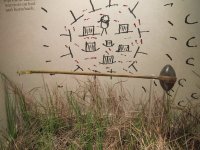
The tag in the lower left corner reads, "Top: This large Pipestone cannunpa, with a T-shaped bowl and wooden pipestem, was smoked at the Fort Laramie treaty negotiations in 1868. As a result of the treaty, the U.S. government recognized the Lakota's possession of the Black Hills as a part of the larger Greater Sioux Reservation. Bottom: A pipestone bowl with lead inlay carved around 1900. The stem, wrapped in the skin of a male mallard duck, is decorated with red quills."
In addition to recognizing the Black Hills to be a Lakota possession, the Ft. Laramie Treaty recognized about 1/3 of South Dakota and large tracts of Nebraska, Wyoming, and a small part of Montana to also be Lakota possessions. "The treaty formed the basis of the 1980 Supreme Court case, United States v. Sioux Nation of Indians, in which the court ruled that tribal lands covered under the treaty had been taken illegally by the US government, and the tribe was owed compensation plus interest. As of 2018 this amounted to more than $1 billion. The Sioux have refused the payment, demanding instead the return of their land." (Wikipedia)


From the museum I walked up to the excavation sites at Carnegie and University Hills, the two hills seen below. It was a walk of about 2 miles from the Visitor's Center. The Niobrara River is the darker green strip in the picture below the hills. The Niobrara River empties into the Missouri River on the other side of Nebraska. The Platte River about 100 miles south was the route of the Oregon Trail. It's a larger river than this one and today is lined with trees along it's length but in the mid 1800's when the pioneers traveled along it there were no trees and it would probably have looked something like this.
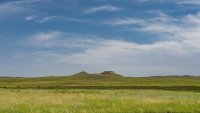
The Niobrara River. The trees in the distance are at a homestead. Otherwise, there are no trees in this area.
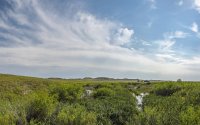
Rocky Mountain Bee Plant
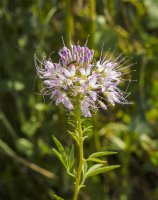
Showy Milkweed
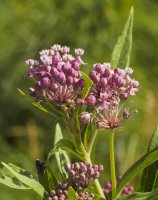
Band-winged Meadowhawk Dragonfly. There were a lot of dragonflies around. I saw a couple other varieties but was not able to get a photo of them.
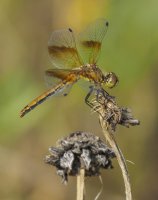
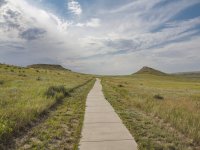
There a lot Tiger Beetles along the sidewalk. This is a variety I have not seen before and haven't yet been able to identify.
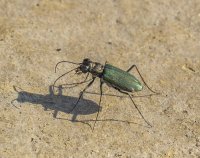
The Visitor's Center as seen from the archeological excavations.

Mountain Short-horned Lizard
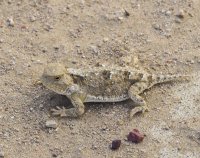
Fossil excavations at one of the hills.
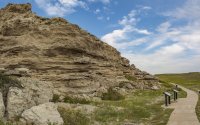

A storm started to come up on my walk back to the Visitor's Center.

Thanks for looking.
If you like history and geology / fossils this is good place to visit. There's a nice little museum at the Monument. Half of it is devoted to fossils found at the site, but the other half actually fascinated me more. In 1880 James Cook homesteaded a ranch in this location. Mr Cook was something of a renaissance man. Besides being a successful rancher he became interested in fossils from a chance encounter with a Yale University professor while guiding hunting trips in the Big Horn mountains in Wyoming. In the mid 1880's he found fossils on his ranch and invited his contact from Yale to make a visit to see the fossils. It turned out to be quite a find. Beginning in about 1900 and continuing for about 30 years excavations were conducted by several universities and museums at two hills on the ranch. The hills are named University Hill and Carnegie Hill (for the Carnegie Museum. The special significance of the hills were that the tops of the them are all that remains of an ancient waterhole. The reason for the massive die-off at the water hole is uncertain, but there is layer of mudstone on the hilltops containing hundreds, maybe thousands, of remains of animals from that ancient time, many of which were entire skeletons. Fossils found at the Agate Fossil beds include: (from Wikipedia)
- Miohippus, an ancestor of the modern horse,
- Menoceras, a pony-sized rhinoceros,
- Amphicyon, a bear dog,
- Daeodon, the largest Entelodont (giant pig-like ungulate),
- Stenomylus, a gazelle-like camelid, and
- Palaeocastor, land beavers that dug large corkscrew-shaped burrows (Daemonelix)
- Moropus, a chalicothere which are relatives of rhinos and horses.
The other half of the museum contains a collection of Plains Indian relics given to Mr. Cook by tribes living in the area. The 1880's basically marked the end of Horse Culture of the Plains Indians. Custer's Last Stand at Little Bighorn occurred in 1876. Before that time, but especially after Little Bighorn the U.S. army was engaged in continuous military operations against the Plains Indians to subdue them. The museum contains an impressive collection of items from the height of the Plains Indian Horse Culture. There are some items in the museum that I was astonished to see in such a remote museum. They probably belong in a more prominent museum like the Smithsonian. There are a few authentic items from the battle at Little Bighorn and at least a one other battle between a Sioux tribe and the U.S. Army. A personal item belonging to Crazy Horse which was removed at burial by his sister after he was killed while in U.S. Army custody at Ft. Robinson (a little farther north in Nebraska) is also in the museum. Last year I went to an event at a Nebraska State Park (a little farther south in Nebraska) that, among other things, had a gathering of Sioux from Pine Ridge Reservation along the South Dakota - Nebraska border. Some people from the tribe had been working with the Smithsonian Museum to help them identify and preserve items in the Smithsonian collection from the Plains Indians. As a thank you the Smithsonian Museum sent several items to the museum at the State Park for the event. As cool as that stuff was, it wasn't any better than the stuff in this museum. I think that the only explanation for items of such historical significance being in such a remote museum is that Cook's family must have insisted that these things remain at the Monument as a condition for giving them.
The fossils on the right are from a rhinoceros. The one on the left is a bear-dog.

A camel.

I'm afraid I didn't get a picture of the high-tops

Some ceremonial moccasins also had beads on the bottom.



A Sioux wedding dress.

The "Battle of Greasy Grass" is the Sioux name for Custer's Last Stand.

This copy of the original cowhide describing the Battle of Little Bighorn described above is displayed in the Museum. There was no indication where the original is, but I suspect it is probably preserved at the Museum.

This flintlock was used by Sioux Indians in the Battle of Little Bighorn.


This is the club that American Horse used in his hand-to-hand fight with Captain Fetterman as mentioned above. Note the broken handle as described above.

The tag in the lower left corner reads, "Top: This large Pipestone cannunpa, with a T-shaped bowl and wooden pipestem, was smoked at the Fort Laramie treaty negotiations in 1868. As a result of the treaty, the U.S. government recognized the Lakota's possession of the Black Hills as a part of the larger Greater Sioux Reservation. Bottom: A pipestone bowl with lead inlay carved around 1900. The stem, wrapped in the skin of a male mallard duck, is decorated with red quills."
In addition to recognizing the Black Hills to be a Lakota possession, the Ft. Laramie Treaty recognized about 1/3 of South Dakota and large tracts of Nebraska, Wyoming, and a small part of Montana to also be Lakota possessions. "The treaty formed the basis of the 1980 Supreme Court case, United States v. Sioux Nation of Indians, in which the court ruled that tribal lands covered under the treaty had been taken illegally by the US government, and the tribe was owed compensation plus interest. As of 2018 this amounted to more than $1 billion. The Sioux have refused the payment, demanding instead the return of their land." (Wikipedia)


From the museum I walked up to the excavation sites at Carnegie and University Hills, the two hills seen below. It was a walk of about 2 miles from the Visitor's Center. The Niobrara River is the darker green strip in the picture below the hills. The Niobrara River empties into the Missouri River on the other side of Nebraska. The Platte River about 100 miles south was the route of the Oregon Trail. It's a larger river than this one and today is lined with trees along it's length but in the mid 1800's when the pioneers traveled along it there were no trees and it would probably have looked something like this.

The Niobrara River. The trees in the distance are at a homestead. Otherwise, there are no trees in this area.

Rocky Mountain Bee Plant

Showy Milkweed

Band-winged Meadowhawk Dragonfly. There were a lot of dragonflies around. I saw a couple other varieties but was not able to get a photo of them.


There a lot Tiger Beetles along the sidewalk. This is a variety I have not seen before and haven't yet been able to identify.

The Visitor's Center as seen from the archeological excavations.

Mountain Short-horned Lizard

Fossil excavations at one of the hills.


A storm started to come up on my walk back to the Visitor's Center.

Thanks for looking.
Last edited:
